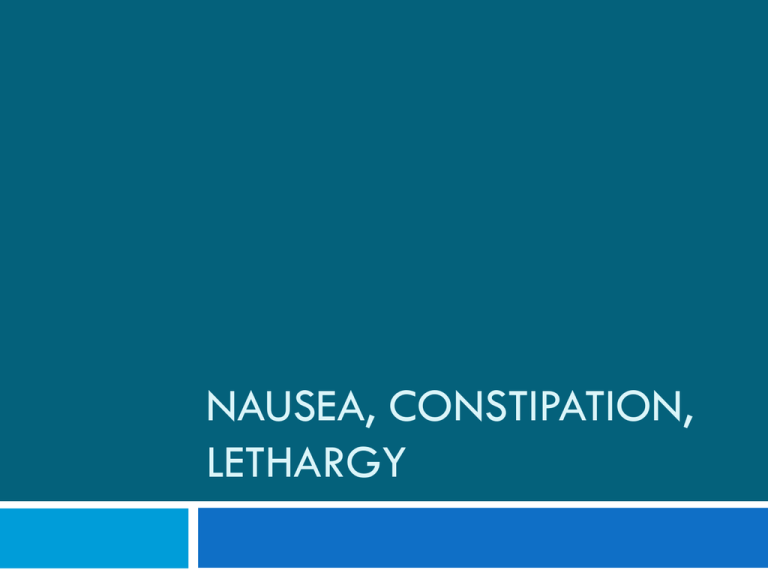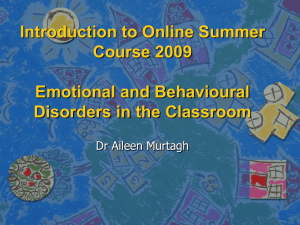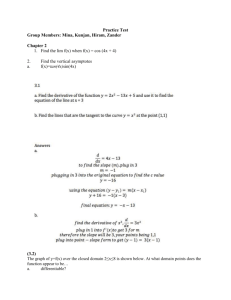
NAUSEA, CONSTIPATION,
LETHARGY
Nausea
Unpleasant thoughts or
smells
Gag reflex
Cerebral cortex
Cerebral cortex mediators are
poorly understood
Cranial nerves
Motion sickness and inner
ear disorders
Labyrinthine
apparatus
Vestibular cholinergic muscarinic
M1 and histaminergic H1
receptors
Gastric irritants and
cytotoxic agents
Gastroduodenal
vagal afferent
nerves
Serotonin 5-HT3 receptors
Intestinal and colonic
obstruction and mesenteric
ischaemia
Nongastric visceral
afferents
Bloodborne emetic stimuli
eg. emetogenic drugs,
bacterial toxins
Area postrema (a
medullar nucleus)
“chemoreceptor
trigger zone”
5-HT3, M1, H1 and dopamine D2
receptors
Nausea
Brain stem
coordination
Neuromuscular
response in the
gut, pharynx
and thoracoabdominal wall
Inspiratory
thoracic and
abdominal wall
muscles contract
High intrathoracic
and
intraabdominal
pressures
Gastric cardia herniates across the
diaphragm and larynx moves upwards
Slow wave
abolition and
initation of
orally
propagating
spike activity
Retrograde
contractions
Forced expulsion
of gastric
contents
Promotes oral
propulsion of the
vomitus
Assisted oral
expulsion of
intestinal contents
Constipation
Chronic
Recent onset
Delayed emptying of the ascending and transverse colon
Prolongation of transit time (esp in the proximal colon)
Reduced frequency of propulsive HAPCs
Outlet obstruction to defecation = evacuation disoders
Tumour or stricture
Idiopathic constipation
Inadequate fibre or fluid intake
Disordered colonic transit
Disordered anorectal function
Can be due to neurogastroenterologic disturbance, certain drugs, advancing age
or due to systemic diseases
Delayed colonic transit usually corrected by biofeedback
Constipation of any cause may be exacerbated by hospitalization or
chronic illnesses that lead to physical or mental impairment and result in
inactivity or physical immobility.
Nausea case-study
A 45 year old male presents to your surgery
complaining of vomiting and a vague, epigastric
pain. Upon questioning, you find that the vomit is
often stained with blood. Looking over his past
consults, you see that he has been referred to
alcoholic rehabilitation, but that he has never
attended.
Murtagh’s DDx for nausea/emesis
Probability diagnosis
All ages: acute gastroenteritis; motion sickness; drugs; various infections
Neonates: feeding problems
Children: viral infections/fever otitis media UTI
Adults: gastritis; alcohol intoxication; pregnancy; migraine
Serious disorders not to be missed
Bowel obstruction: oesophageal atresia (neonates); pyloric obstruction < 3 months;
intestinal malrotation; intussusception; malignancy (e.g. oesophagus, stomach)
Severe infection: botulinum poisoning; septicaemia; meningitis/encephalitis; infective
endocarditis; others (e.g. acute viral hepatitis)
Malignancy
Intracranial disorders: malignancy; cerebellar haemorrhage
Acute appendicitis
Acute pancreatitis
Acute myocardial infarction (e.g. painless)
Murtagh’s DDx for nausea/emesis
Pitfalls (mainly adults)
Pregnancy (early)
Organic failure: liver, kidney (uraemia), heart, respiratory
Labyrinthine disorders: Meniere's syndrome; labyrinthitis
Poisoning: food; chemicals
Gut motility disorders: achalasia
Paralytic ileus
Substance abuse
Radiation therapy
Hypercalcaemia
Functional obstruction: diabetic gastroparesis; idiopathic
gastroparesis
Murtagh’s DDx for nausea
Seven masquerades checklist
Depression possible
Diabetes ketoacidosis
Drugs
Anaemia Thyroid and other endocrine disorders
Spinal dysfunction UTI
Is this patient trying to tell me something?
Possible: extreme stress (e.g. panic attacks)
Consider bulimia (self-induced vomiting)
Functional (psychogenic)
Constipation case study
A 25 year old female presents to your surgery with
pelvic pain and pressure. She also informs you that
she has noticed a stomach/intestinal discomfort, but
is unable to clearly describe what is wrong, except
that she has been constipated for a few weeks now.
Murtagh’s DDx for constipation
Probability diagnosis
Simple constipation: low-fibre diet and bad habit
Serious disorders not to be missed
Intrinsic neoplasia: colon, rectum or anus, especially carcinoma of colon
Extrinsic malignancy (e.g. lymphoma, ovary) Hirschsprung's (children)
Pitfalls (often missed)
Impacted faeces
Local anal lesions
Drug/purgative abuse
Hypokalaemia
Depressive illness
Acquired megacolon
Diverticular disease
Rarities: Lead poisoning; Hypercalcaemia; Hyperparathyroidism; Dolichocolon (large colon);
Chagas' disease; Systemic sclerosis
Murtagh’s DDx for constipation
Seven masquerades checklist
Depression
Diabetes rarely
Drugs
Anaemia Thyroid disorder: hypo
Spinal dysfunction severe only
UTI –
Is the patient trying to tell me something?
May be functional (e.g. depression, anorexia nervosa).
Case-study
A 20 year old female presents to your on-campus
health facility towards the end of semester.
Immediately you notice that she has dark rings
around her eyes and is rubbing her hands
constantly. She tells you that she is constantly tired,
but cannot seem to fall asleep, no matter how hard
she tries.
Murtagh’s DDx for tiredness
Probability diagnosis
Stress and anxiety
Depression
Viral/postviral infection
Sleep-related disorders (e.g. sleep apnoea)
Serious disorders not to be missed
Malignant disease
Cardiac arrhythmia (e.g. sick sinus syndrome)
Cardiomyopathy
Anaemia
Haemochromatosis
HIV infection
Hepatitis C
Murtagh’s DDx for tiredness
Pitfalls (often missed)
‘Masked’ depression
Food intolerance
Coeliac disease
Chronic infection (e.g. Lyme disease)
Incipient CCF
Fibromyalgia
Lack of fitness
Drugs: alcohol, prescribed, withdrawal
Menopause syndrome
Pregnancy
Neurological disorders: Post head injury; CVA; Parkinson's disease
Kidney failure
Metabolic (e.g. hypokalaemia, hypomagnesaemia)
Chemical exposure (e.g. occupational)
Rarities: Hyperparathyroidism; Addison's disease; Cushing's syndrome; Narcolepsy;
Multiple sclerosi; Autoimmune disorders
Murtagh’s DDx for tiredness
Seven masquerades checklist
Depression
Diabetes
Drugs
Anaemia
Thyroid disorder
Spinal dysfunction
UTI
Is the patient trying to tell me something?
Highly likely











